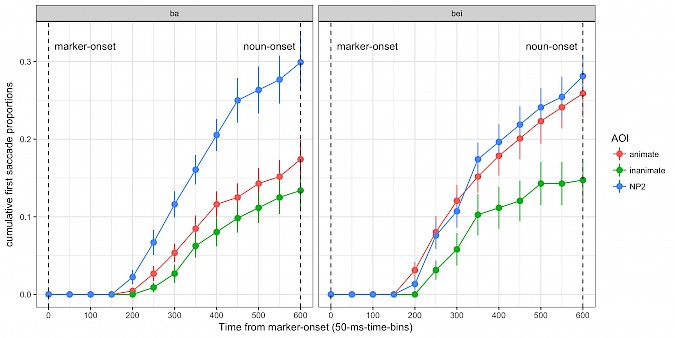Processing discourse referents in Mandarin active and passive SOV sentences
In Mandarin Chinese, the canonical word order SVO can be altered to SOV. One possibility is to use markers such as bèi or bǎ. The fundamental difference between these two is that bǎ yields an active sentence and bèi yields a passive. As a consequence, the nouns in the subject and object slot receive different thematic roles in both structures. In the bǎ-construction the object is assigned the role of a patient or theme, in the bèi-construction it is the role of an agent. In this project we ask, in how far information derived from these markers affect the interpretation of referents preceding and the prediction of referents following the markers.
In a visual world study, participants heard sentence pairs, that had identical beginnings (e.g., zhè gè chú shī de qī zǐ ‘This chef’s wife’), but continued differently after the subject (qī zǐ ‘wife’): in the bèi-condition, as a passive (bèi dǎi tú bǎng jià le ‘(was by the) gangster kidnapped’), in the bǎ-condition, as an active (bǎ kā fēi zhǔ le ‘(the) coffee made’). Sentence pairs (N=16) were matched with identical visual stimuli, e.g. a display showing a chef, a woman, a gangster, a cup of coffee. Two objects corresponded to the nouns mentioned in the sentences’ beginnings (chef, wife). Depending on condition, one of the remaining objects was referred to after the marker. In the bèi-condition, this was the animate one (gangster), in the bǎ-condition, it was the inanimate one (cup of coffee). Importantly, filler items (N=16) were very similar to critical items (8 bèi- and 8 bǎ- sentences), but the nouns mentioned after bèi/bǎ never corresponded to any of the objects in the visual display. Word onset times were matched for sentence pairs up to the onset of the target nouns. Two experimental lists ensured that every participant (N=28) encountered only one pair partner, 8 from each condition (but all fillers). Critical and filler trials were randomized. Participants had to listen to the sentences and give a yes/no answer to a question testing event structure comprehension.
If participants initially assign the nouns that precede the markers the role of an agent (cf. Huang et al. 2013), more attention to the corresponding objects (e.g., wife) in the bèi-condition is predicted after the marker was perceived, because this initial assignment would have to be revised. Also higher error rates in the comprehension test can be expected along these lines. If participants use information derived from the markers to predict upcoming referents, more attention directed to animate referents in the bèi-condition before target-onset is predicted (cf. Kamide et al. 2003).
Analyses of the ET data show that (1.) there is no difference in attention allocation to objects corresponding to nouns preceding bèi compared to the same objects in the bǎ-condition; (2.) only in the bèi-condition, participants direct significantly more attention to animate referents than to inanimate referents before target noun onset; (3.) attention to animate referents is significantly higher in the bèi-condition than in the bǎ-condition before target noun onset. Participant’s performance in the comprehension test does not differ between conditions.
In sum, no evidence for the revision of initial role interpretation (nouns preceding the markers) was detected, which suggests that participants (can) postpone argument linking to some extent. However, as soon as information is derived from the markers at issue in the present study, this is used to predict upcoming referents, which implies that a stable event representation has been constructed before the following noun is perceived. Since bèi is more reliable than bǎ (cf. Li et al. 1993), Mandarin speakers, are more likely to link a visual animate referent to the yet-to-be-filled agent slot in their event representation than they are to link an animate referent to a patient slot, or an inanimate referent to theme slot.

Project publications
- Processing discourse referents in Mandarin active and passive SOV sentences
Ran Wang & Gerwien, J. (poster presentation). Processing discourse referents in Mandarin active and passive SOV sentences. 30th Annual CUNY Conference on Human Sentence Processing, March 29-April 1, 2017, Boston, Massachusetts. abstract and poster
- The interpretation and prediction of event participants in Mandarin verb-final active and passive sentences
Gerwien, J. (2019). The interpretation and prediction of event participants in Mandarin verb-final active and passive sentences. Journal of Cultural Cognitive Science. 1-27. https://doi.org/10.1007/s41809-019-00049-x